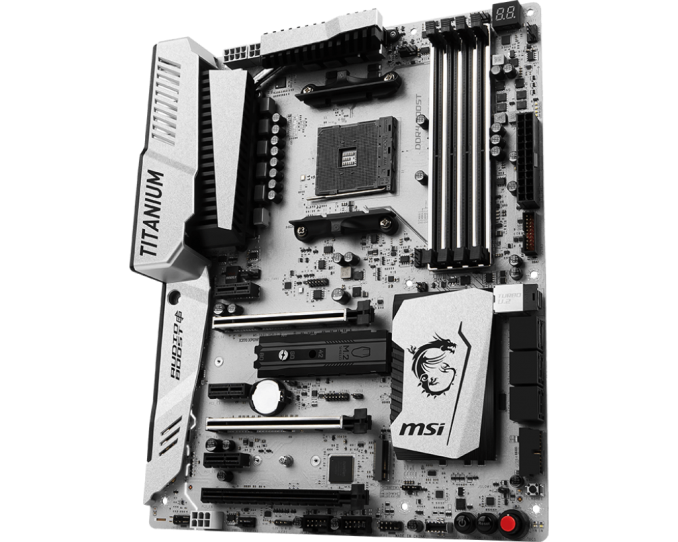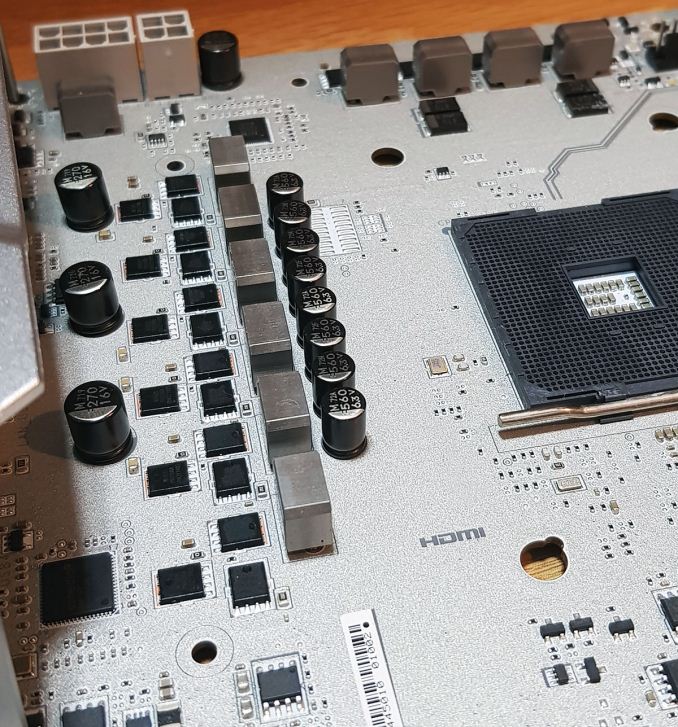The MSI X370 XPower Gaming Titanium Motherboard Review: A Silver Flagship
by Gavin Bonshor on April 13, 2018 8:00 AM ESTMSI X370 XPower Gaming Titanium Conclusion
The MSI X370 XPower is currently priced at $255 from Amazon US which puts it as one of the most expensive X370 motherboards on the market, alongside the likes of the ASUS ROG Crosshair VI Extreme ($350) and the ASRock X370 Fatal1ty Professional Gaming ($250). The board has one of the most unique stylings of any X370 motherboard (even moreso than the ASRock X370 Taichi at $220) which MSI does in fact include a fully silver colored PCB throughout its entirety.
The performance shown by the XPower was pretty average as far as synthetic benchmarks go, but in relation to our game testing, it sat consistently towards the bottom of our graphs, but not far enough away from the mark to signify an ‘anomaly’. Power consumption for such feature packed ATX board proved average as well, despite the additional controlelrs and features on board. As with the rest of the boards we have previously tested on the AM4 socket, none of them have been optimized for DPC latency, but this motherboard was 'best of the rest' behind the ASRock boards we have tested.
There has been some negative feedback by some members of the press in regards to the quality of power delivery on the X370 XPower, as MSI uses the same Nikos PowerPAK PK616BA MOSFETs on this board, the same as the ones on the B350 Tomahawk ($98) which we previously reviewed. This board is nearly 3x of the price with similar power delivery components. Whether MSI felt the need to not overpower the ten-phase power delivery like some manufacturers do, or they were more than happy with the quality of the components, it’s hard for me to comprehend the decision. The design is actually, technically speaking, an eight-channel offering with it being a 6+2 phase with an International Rectifier IR3598 doubler on the SOC side; thus, giving us a 6+4 power phase design overall.
The direction that the XPower branding has gone from, from elite level extreme overclocking to being targeted directly at gamers, is a relatively smart option as far as business decisions go, and the obvious cost cutting on the phases could be attributed to it - gamers don’t really need expensive and overkill power delivery configuration and everything bar the most brutal and world leading overclocks will be more than achievable on this particular board.
While MSI has opted out of including onboard Wi-Fi and Bluetooth connectivity, there is a single Gigabit LAN port which is powered by an Intel I211AT controller. A total of eight USB Type-A ports split between four USB 3.1 Gen1, three USB 2.0 ports and a single USB 3.1 Gen2 port are present on the rear panel, and an additional four USB 2.0 and a further four USB 3.1 Gen1 Type-A ports can be used via internal headers. A single USB 3.1 Gen2 Type-C port is featured on the rear panel with the option to add another via an onboard header. The new Ryzen APUs such as the Ryzen 5 2400G ($169) can make use of the included HDMI 2.0 and DisplayPort inputs, although I do find it rather interesting that MSI hasn’t opted to save a little cost by not using HDMI 1.4 or spent the additional in another area of the board, given that this motherboard is screaming for discrete graphics card users.
The MSI X370 XPower Gaming Titanium is a very attractive offering to gamers willing to spend the money on unique aesthetics, baring in mind RGB isn’t bundled to this board without external LED strips. For a gaming system that needs a good NVMe drive, one or two GPUs, and few SATA storage drives, the system does offer pretty much everything a gamer could possibly use; barring the lack of built in Wi-Fi or 10 GbE/TB3.
It’s hard to differentiate the major characteristics on paper of the X370 XPower and MSI’s own X370 Gaming M7 ($200), aside from the aesthetics and a couple of differences in the choice of controllers used. If anything, the general change in direction of branding from overclocking performance to gaming could certainly be clearer as a few things extreme overclockers would be looking for, such as an external clock generator and a slightly beefier power delivery, are no longer part of this brand.
All that aside, the X370 XPower Gaming Titanium has a solid BIOS, a good software package, and with a solid price reduction it would be a much more attractive offering in today’s current market.












19 Comments
View All Comments
T1beriu - Friday, April 13, 2018 - link
BIOS Build Date: 09/19/2017.WOW.
T1beriu - Friday, April 13, 2018 - link
I see that MSI released 2 BIOS versions since then.Ian Cutress - Friday, April 13, 2018 - link
That's partly my fault. Gavin tested this board back in late January, wrote it up over Feb, and it's been in my to-edit list for a few weeks. The two BIOS revisions were 1/29 and 3/19, mostly relating to new processor support and some more memory tweaks, as well as Win7 support.ManuelDiego - Friday, April 13, 2018 - link
Plus we are like 1 week away of X470, right? Not sure i see the point of releasing this board now, TBH.Ian Cutress - Friday, April 13, 2018 - link
Bottom of first page, questions answered.ManuelDiego - Friday, April 13, 2018 - link
I see, thanks for the addendum, Dr. Cutress.Topweasel - Friday, April 13, 2018 - link
Those are kind of BS answers for a lack of effort to review the products when they launched over a year ago. This was MSI's Launch flagship motherboard, they only now (ish) gave you a board to review? I doubt that, considering it's price, and all of the review samples that AMD gave out were with the Crosshair, MSI would have been handing these out like candy hoping reviews would get people to get this over the RoG.Above you noted that the review was basically finished 4 months ago. Back when people would have actively purchasing X370 boards. While I am sure that the mobo companies will sell this next to the new boards, without steep discounts (ones that a Premium board like this are unlikely to get to make them less interesting than a mid level X470 board) the default purchasing habits will be the new series. Topping it off people buying this late into the cycle want to know more about quirks, long term issues, Bios update history, support level type stuff to make sure they are getting the most stable platform on which to build their computer around. Stuff that is missing because this isn't a long term review, it's a normal review near the end of its natural cycle.
I know the real answer and while disappointing you shouldn't be ashamed of. We want the best technical information and the best approach. You give us that, and the real answer being you were backed up with all of the hardware launches last year that you prioritized products that mattered to the larger portion of your readership I think most of us understand. Otherwise considering it was pretty much a year on the dot that you started reviewing products ancillary to the Ryzen release. That the secrecy behind reviewing products this late into the cycle has more to do with Purch's relationship with Intel and not down to workload.
Ryan Smith - Friday, April 13, 2018 - link
"That the secrecy behind reviewing products this late into the cycle has more to do with Purch's relationship with Intel and not down to workload. "Let me be 100% crystal clear here: AnandTech's editorial calendar is set by me. Purch has taken an extremely light hand to AnandTech overall, and has never dictated what content we should run.
It does a massive disservice to Ian, Gavin, and my other editors when anyone accuses, insinuates, or otherwise implies that they are acting with ulterior, unethical motives. These are some of the hardest working people I know - Ian in particular - and it was my choice alone in determining our editorial priorities. Which yes, meant having Ian work on some other things (like digging into the CTS story) ahead of editing motherboard reviews.
Topweasel - Friday, April 13, 2018 - link
I want to point out I wasn't actually suggesting that was the case. I am sure it's all about hands available and deciding what products will get the most re-viewership (for example more I7's than Ryzen 7's sold means more people would be interested in Z270/370 reviews than X370). But it's better to actually say that than try to play it off like all of a sudden you got 10 AM4 300 series boards in a couple months before the refresh and that there is this demand for reviews of the product. This isn't the usually week or two later with more in depth information, this is nearing the end of a products viable marketable sales (but as noted not the end of sales).But dancing around the actual reason for the delay and considering the poorness of the timing (almost exactly a year after launch). It causes people to generate conspiracy theories. Without knowing better that would be the one that would come to my head. Why almost exactly a year, what is the significance of the year? It almost seems like a time limited exclusivity deal like games some times have. It would then spiral from there, why? Well Purch and Intel have a relationship about very high level advertising through regular media deal going on.
Sure some fans aren't going to like being told their product doesn't generate enough views. But obviously a choice was already made that was going that their readership wasn't worth the ROI in man hours. So it's not like that guy not wanting to read a review after being told that is going impact you that much since again his market was to small for the effort anyways. But in the end most reasonable people are going to welcome more transparency there rather than looking for another reason to call Anandtech a schill site. I don't think it is. Never have.
Just think about that in the future. It's one of the things that was great about Anandtech back in the day and will keep the site a worthy one coming back. Don't pull the punches on reviews, don't dance around choices made. Just be as straightforward and technical as possible. Doing otherwise invites critism and over scrutinization.
Qasar - Saturday, April 14, 2018 - link
Topweasel here is a better idea....if you think you can do better then anandtech does now.. then how about you start your own review site, and do them yourself based on what you feel your readers will want at any given time.
the staff here have stated over and over again, they decide what gets reviewed, when and when it is posted on here, should x370 and AM4 related stuff have been reviewed months ago.. yes.. but we dont know their schedule, work load, or whats in the queue to be reviewed or posted. i remember a post a while back that said they have a new reviewer for amd related product and are getting him up to speed, that could of been part of the delay... either way. i keep coming back here cause of the quality of these reviews and write ups, and how deep the guys and anandtech have always gone into something on the tech side.. and i will keep coming back for that.. even if a lot of it.. i dont understand cause its above my pay grade :-) this is one of the best places to go for reviews and the tech inside a lot of the products on here